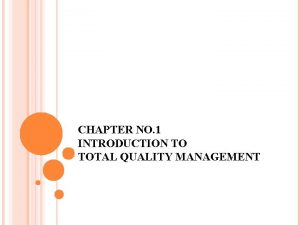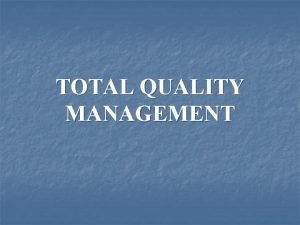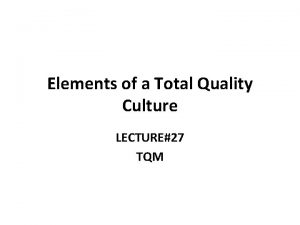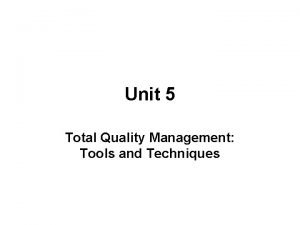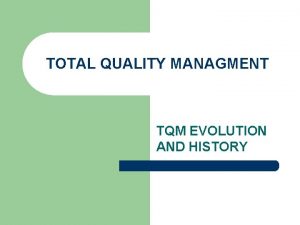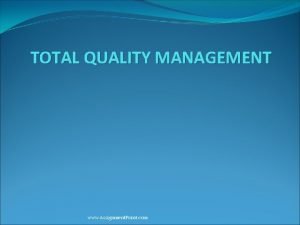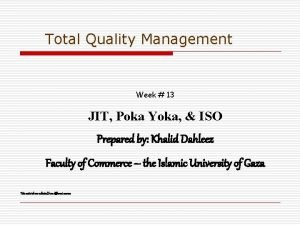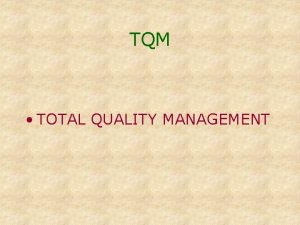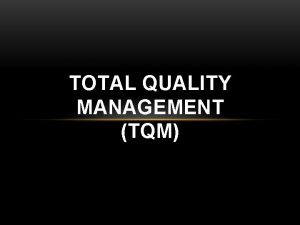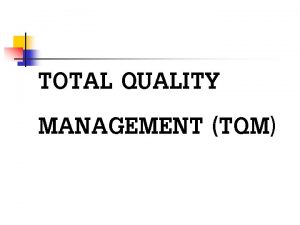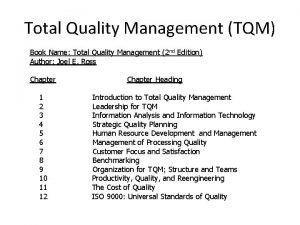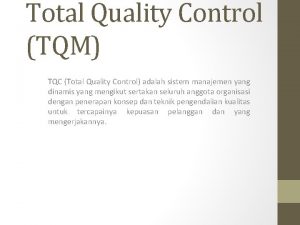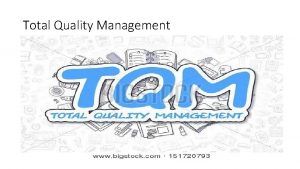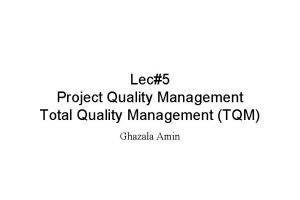TOTAL QUALITY MANAGEMENT INTRODUCTION TO TQM What is











- Slides: 11

TOTAL QUALITY MANAGEMENT

INTRODUCTION TO TQM What is TQM? TQM is the integration of all functions and processes within an organization in order to achieve continuous improvement of the quality of goods and services. The goal is customer satisfaction.

Five Approaches of Defining Quality n Harvard professor David Garvin, in his book Managing Quality summarized five principal approaches to define quality. n Transcendent Product based User based Manufacturing based Value based n n

System MANAGEMENT OF PROCESS QUALITY Driver SENIOR EXECUTIVE LEADERSHIP HUMAN RESOURCE DEVELOPMENT AND MANAGEMENT STRATEGIC QUALITY PLANNING CUSTOMER FOCUS AND SATISFACTION QUALITY AND OPERATIONAL RESULTS INFORMATION AND ANALYSIS System Approach for TQM

Characteristics of TQM Leader n n n n Visible, Committed and Knowledgeable A Missionary Zeal Aggressive Targets Strong Drivers Communication of Values Organization Customers Contact

Customer Satisfaction Three Part System Human Resource Management Company Operations (Processes) Customer Expectations Customer Satisfaction

Indicators for Customer Satisfaction n n n n Frontline empowerment Excellent hiring, training, attitude and morale for front line employees Proactive customer service system Proactive management of relationship with customers Use of all listening posts Quality requirements of market segment Commitment to customers Understanding customer requirements Service standards meeting customers requirements

Quality Costs Cost of Prevention n Prevention costs include those activities which remove and prevent defects from occurring in the production process. n Included are such activities as quality planning, production reviews, training, and engineering analysis, which are incurred to ensure that poor quality is not produced. Appraisal n Those costs incurred to identify poor quality products after they occur but before shipment to customers. e. g. Inspection activity.

Quality Costs Internal Failure n Those incurred during the production process. n Include such items as machine downtime, poor quality materials, scrap, and rework. External Failure n Those incurred after the product is shipped. n External failure costs include returns and allowances, warranty costs, and hidden costs of customer dissatisfaction and lost market share.

Benefits of TQM n n n Greater customer loyalty Market share improvement Higher stock prices Reduced service calls Higher prices Greater productivity

Conclusion Remember the earth revolves around the CUSTOMER. Quality begets customers and customers beget quality. Let us all have action plans to support quality, this will make the world happy and earn us the blessing of God Almighty. “Actions are direct reflection of one’s intentions” (Al-Quran)
 Fundamental principles of tqm
Fundamental principles of tqm Introduction to total quality management
Introduction to total quality management Introduction to tqm
Introduction to tqm Contemporary issues in management ppt
Contemporary issues in management ppt Operations management with total quality management book
Operations management with total quality management book Which of the gurus would be the father of quality control?
Which of the gurus would be the father of quality control? Quality culture in tqm
Quality culture in tqm Interrelationship diagram
Interrelationship diagram Tqm inventor
Tqm inventor Total quality management assignment
Total quality management assignment Poka yoka
Poka yoka Total quality management system
Total quality management system

